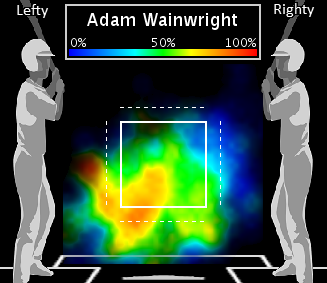Axford Getting Tagged in Two-Strike Counts
 David Golebiewski |
David Golebiewski |  Friday, August 30, 2013 at 3:06PM
Friday, August 30, 2013 at 3:06PM
Few relievers were as dominant as John Axford during his first two years as the Milwaukee Brewers' closer. Axford placed tenth among qualified 'pen arms in both park-and-league adjusted ERA (183 ERA+) and Wins Above Replacement (3.8) in 2010 and 2011, reaching the apex of his profession after enduring a career arc at times promising (he was a touted Notre Dame recruit) and depressing (he signed as a free agent with the Yankees 2006 after a stint with the Melville Millionaires, a Canadian summer league team that, ironically enough, doesn't pay players).
While he won't be suiting up in Saskatchewan again any time soon, Axford's last two seasons in the majors have been brutal. He has the fourth-worst adjusted ERA (88 ERA+) and ranks dead last in WAR (-1.6) among relievers since the start of the 2012 season, which helps explain how the St. Louis Cardinals were able to pick him up today for a player to be named.
The big difference between the version of Axford closing out games and finishing in the top 10 in Cy Young Award voting and the version mopping up blowouts is home run prevention. Axford surrendered a mere 0.3 home runs per nine innings in 2010-11, but 1.5 HR/9 in 2012-13. He's having a particularly hard time keeping the ball in the park in two-strike counts, when he seemingly should have hitters in his clutches.
Axford allowed just one home run in two-strike counts during the 2010-11 seasons, and he limited batters to a .169 slugging percentage -- more 100 points lower than the MLB average for relievers over that time frame (.260).
Hitters' slugging percentage vs. Axford in two-strike counts, 2010-11
The last two years, though? Axford is getting touched up far more often when hitters have their backs against the wall.
Hitters' slugging percentage vs. Axford in two-strike counts, 2012-13
Axford has coughed up the most two-strike home runs among relievers over the 2012-13 seasons (nine), and he's allowing a .318 slugging percentage.
Pitch selection may be part of the problem. He's throwing more two-strike fastballs in recent years (64% during the 2012-13 seasons) than he did as a shutdown closer (55% in 2010-11), an approach he might want to reconsider. Seven of the nine homers that Axford has given up in two-strike counts in 2012-13 have come off of the heat. Breaking out the breaking stuff more often could help Axford finish off hitters in St. Louis.
 Brewers,
Brewers,  Cardinals | tagged
Cardinals | tagged  John Axford,
John Axford,  Milwaukee Brewers,
Milwaukee Brewers,  St. Louis Cardinals
St. Louis Cardinals



